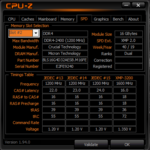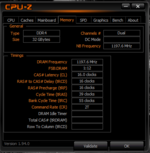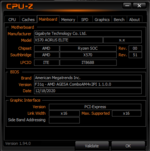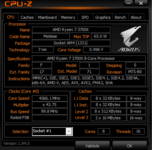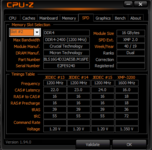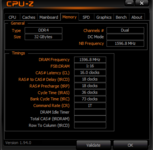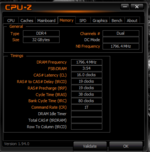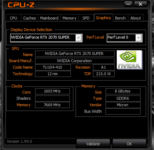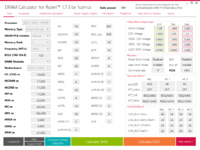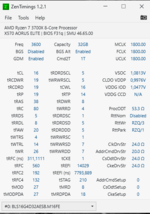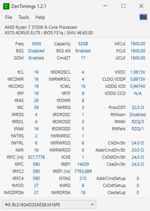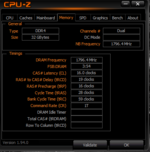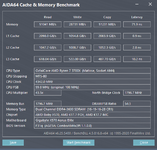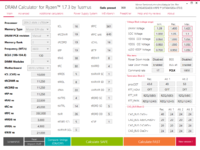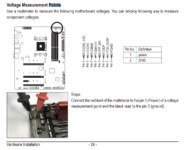Die X570 Motherboards der Gigabyte Aorus Serie bestehen momentan aus 8 Modellen. Darunter gibt es das Modell Aorus X570 XTreme, das speziell für eine Wasserkühlung entwickelt wurde. In Verbindung mit Prozessoren der dritten Generation (Ryzen 3000) stehen mehrere PCIe 4.0 Steckplätze zur Verfügung.
Die Serie besteht aus folgenden Modellen:
Die aktuellen BIOS Versionen findet man entweder auf der jeweiligen Modellseite von Gigabyte oder in der Ultimativen AM4 UEFI/BIOS/AGESA Übersicht (15.11.19).
Ich hoffe auf rege Beteiligung. Es handelt sich um einen dynamischen Informationsprozess, der diesem Eingangspost auch erweitern soll. Deshalb bitte ich um Information, wenn bestimmte Informationen bereits in diesem Eingangspost erscheinen sollen.
FAQ:
1. BIOS Nomenklatur: Bei Gigabyte kann man anhand der Versionsnummer direkt erkennen, ob es sich um ein Release oder um eine Testversion handelt. Bei letzterer endet die Versionsnummer mit einem Buchstaben. (oNyX`)
2. meine NVMe PCIe 3.0 SSD geht nicht
Das Problem läßt sich im Allgemeinen dadurch beheben, daß man dem Board explizit mitteilt, daß es PCIe 3.0 zu verwenden hat. Der Eintrag nennt sich "PCI Slot Configuration) und kann manuell auf Gen1 bis Gen4 sowie Auto gestellt werden. Bitte beachtet, daß die Systemweit gilt und so z.B. auch eine 5700 unter dem eingestellten Wert läuft.
3. Meine PCIe x1 Karte geht nicht
Das ist momentan noch ein Bug im BIOS. Vereinzelt kann es auch zu Bootproblemen führen. Momentan ist der einzige Workaround, die Karte zu entfernen
4. PBO funktioniert nicht
Auch dies ist ein Bug um BIOS. Er tritt seit BIOS F10A/AGESA 1.0.0.4 auf. Das BIOS liest hierbei die Boardwerte für EDC nicht aus und deaktiviert daraufhin den PBO-Boost. Man kann dies momentan umgehen, indem man den EDC-Wert explizit auf 0 setzt. Bei den AMD-Performance -> PBO Einstelllungen muß eine EDC von Null eingetragen werden.
5. Ich habe ein CMOS Clear durchgeführt, aber es werden weiterhin die alten Settings verwendet.
Bei einem CMOS Clear sollten eigentlich alle Einstellungen auf Default zurückgesetzt werden. Das passiert auch fast komplett. Jedoch bleiben die Einstellungen im AMD-Overclocking Menübereich komplett erhalten und werden nach Start des Systems auch verwendet. Man muß dort die Werte händisch löschen!
6. Seriennummer-Nomenklatur:
Man kann anhand der Seriennummer das Produktionsdatum des Boards ermitteln. Lautet die Seriennummer am Beginn z.B. SN1928xxxxxxxx besagen die Stellen 3&4 (19) das Produktionsjahr, die Stellen 5&6 hingegen die Produktionswoche. Das Board mit obiger Seriennummer wurde alsoo in der Woche 28 des Jahres 2019 produziert.
Ich bitte dabei zu berücksichtigen, daß in Deutschland die erste Kalenderwoche unterschiedlich zu den USA ermittelt wird.
7. Wem das Sägen des CPU-Kühlers auf den Nerv geht, kann diesen an die Leine nehmen. Bei oNyX` zeigten sich folgende Werte als besonders hilfreich
1. 27% default
2. 30% 60c
3. 50% 70c
4. 75% 75c
5. 100% 80c
Diese Werte können direkt im Bios oder via SIV eingetragen werden.
8. Ich möchte hier darauf hinweisen, daß das Schreiben von Werten im Ryzen Master mit größter Vorsicht zu genießen ist. Es werden z.B. bei RAM-Werten Dinge direkt in den AGESA Bereich geschrieben, der für Mainboardhersteller gesperrt ist. Es kann und kam dabei dazu kommen, daß das Board nicht mehr lauffähig ist. Hat man bereits Werte geschrieben, kann man mit der Prozedur:
- BIOS inkl. Agesa neu flashen
- BIOS Hardware-Reset
das Board wieder in einen lauffähigen Zustand versetzen. Dies ist aber nicht garantiert. Auf OCN musstem mehrere Nutzer ihr Board trotz der Prozedur zurücksenden. Diese Warnung betrifft mWn ALLE X570 Boards.
9. AMD hat für hwInfo festgelegt, daß das Interwall zum Auslesen der Werte alle 500ms erfolgen soll. Standardmäßig sind hier 2 Sekunden parametrisiert. Ich bitte dies bei Benchmarks etc. zu berücksichtigen
10. Sollte das BIOS bei der Nutzung von Tastatur und/oder Maus ruckeln, kann man im BIOS mit dem Tastaturkürzel "Strg-Alt-F6 " die Auflösung bis zum nächsten Reboot auf den VGA Modus limitieren. Dies sollte den Eingabe-Lag beheben.
Hilfreiche Links:
1. Neben dem Einstieg über die Gigabyteseite kann man den Downloadbereich auch via Aorus.com erreichen.
2. ein weiterer guter Anlaufpunkt für die neueste Beta ist TweakTon's Forum GIGABYTE Latest Beta BIOS
3. Wer ein X570 Master besitzt und seinen Ryzen 3000 übertakten will, findet im Gigabyte X570 AORUS Master Overclocking Thread eine umfangreiche Anleitung
4. Eine weitere Anleitung zum Übertakten der Ryzen 3000 auf einem Gigabyte Board findet Ihr im GIGABYTE AMD X570 Ryzen Overclocking Guide
Danksagung:
Einen großen Dank an oNyX` und Dan Hot für die wertvollen Hints und Tips
--- History ---
2019 11 16 | GuruSMI | Initiale Version
2019 11 30 | GuruSMI | Anpassung wegen Kompatibilitätserweiterung (Ryzen 2000G)
2020 01 09 | GuruSMI | Einfügen hilfreicher Links, Aktualisierung der FAQ
2020 01 22 | GuruSMI | Änderung des Threadtitels
2020 01 22 | Emissary42 | Verschieben des Threads in das Unterforum "Mainboard-Sammelthreads"
2020 08 27 | GuruSMI | Erweiterung der FAQ
Die Serie besteht aus folgenden Modellen:
| Name und Link zur Website | X570 AORUS ELITE | X570 AORUS ELITE WIFI | X570 AORUS MASTER | X570 AORUS PRO | X570 AORUS PRO WIFI | X570 AORUS ULTRA | X570 AORUS XTREME | X570 GAMING X | X570 I AORUS PRO WIFI | X570 UD |
| Preisvergleich | Aktuelle Preise | Aktuelle Preise | Aktuelle Preise | Aktuelle Preise | Aktuelle Preise | Aktuelle Preise | Aktuelle Preise | Aktuelle Preise | ||
| Formfaktor | ATX; 30.5cm x 24.4cm | ATX; 30.5cm x 24.4cm | ATX; 30.5cm x 24.4cm | ATX; 30.5cm x 24.4cm | ATX; 30.5cm x 24.4cm | ATX; 30.5cm x 24.4cm | E-ATX; 30.5cm x 27.0cm | ATX; 30.5cm x 24.4cm | Mini-ITX; 17.0cm x 17.0cm | ATX; 30.5cm x 24.4cm |
| Unterstützte Prozessoren |
|
|
|
|
|
|
|
|
|
|
| VRM | 7 reale Phasen (6+1), PWM-Controller: ISL69138 (max. 7 Phasen) | 14 reale Phasen (12+2), PWM-Controller: XDPE132G5C (max. 16 Phasen) | 8 reale Phasen (6+2), PWM-Controller: IR35201 (max. 8 Phasen) | 8 reale Phasen (6+2), PWM-Controller: IR35201 (max. 8 Phasen) | 16 reale Phasen (14+2), PWM-Controller: XDPE132G5C (max. 16 Phasen) | 7 reale Phasen (5+2), PWM-Controller: ISL69147 (max. 7 Phasen) | 8 reale Phasen (6+2), PWM-Controller: IR35201 (max. 8 Phasen) | 7 reale Phasen (5+2), PWM-Controller: ISL69147 (max. 7 Phasen) | ||
| MOSFETs CPU | 12x 50A SIC634 | 12x 50A IR3556 | 12x 40A IR3553 | 12x 40A IR3553 | 14x 70A TDA21472 | 10x 46A 4C10N/20x 4C06N | 6x 70A TDA21472 | 10x 46A 4C10N/20x 4C06N | ||
| MOSFETs SoC | 2x 46A 4C10N/4C06N | 2x 50A IR3556 | 2x 46A 4C10N/4C06N | 4x 46A 4C10N/4C06N | 2x 70A TDA21472 | 4x 46A 4C10N/4C06N | 2x 40A IR3553 | 4x 46A 4C10N/4C06N | ||
| Arbeitsspeicher |
Dual channel memory architecture Support for non-ECC Un-buffered DIMM 1Rx8/2Rx8/1Rx16 memory modules Support for Extreme Memory Profile (XMP) memory modules |
Dual channel memory architecture Support for non-ECC Un-buffered DIMM 1Rx8/2Rx8/1Rx16 memory modules Support for Extreme Memory Profile (XMP) memory modules |
Dual channel memory architecture Support for non-ECC Un-buffered DIMM 1Rx8/2Rx8/1Rx16 memory modules Support for Extreme Memory Profile (XMP) memory modules |
Dual channel memory architecture Support for non-ECC Un-buffered DIMM 1Rx8/2Rx8/1Rx16 memory modules Support for Extreme Memory Profile (XMP) memory modules |
Dual channel memory architecture Support for non-ECC Un-buffered DIMM 1Rx8/2Rx8/1Rx16 memory modules Support for Extreme Memory Profile (XMP) memory modules |
Dual channel memory architecture Support for non-ECC Un-buffered DIMM 1Rx8/2Rx8/1Rx16 memory modules Support for Extreme Memory Profile (XMP) memory modules |
Dual channel memory architecture Support for non-ECC Un-buffered DIMM 1Rx8/2Rx8/1Rx16 memory modules Support for Extreme Memory Profile (XMP) memory modules |
Dual channel memory architecture Support for non-ECC Un-buffered DIMM 1Rx8/2Rx8/1Rx16 memory modules Support for Extreme Memory Profile (XMP) memory modules |
Dual channel memory architecture Support for non-ECC Un-buffered DIMM 1Rx8/2Rx8/1Rx16 memory modules Support for Extreme Memory Profile (XMP) memory modules |
Dual channel memory architecture Support for non-ECC Un-buffered DIMM 1Rx8/2Rx8/1Rx16 memory modules Support for Extreme Memory Profile (XMP) memory modules |
| Onboard Grafik | Integrated Graphics Processor: 1 x HDMI port, supporting a maximum resolution of 4096x2160@60 Hz * Support for HDMI 2.0 version, HDCP 2.2, and HDR. Maximum shared memory of 16 GB Note: For 2nd Generation AMD Ryzen™ with Radeon™ Vega Graphics processors/AMD Ryzen™ with Radeon™ Vega Graphics processors only. | Integrated Graphics Processor: 1 x HDMI port, supporting a maximum resolution of 4096x2160@60 Hz * Support for HDMI 2.0 version, HDCP 2.2, and HDR. Maximum shared memory of 16 GB Note: For 2nd Generation AMD Ryzen™ with Radeon™ Vega Graphics processors/AMD Ryzen™ with Radeon™ Vega Graphics processors only. | Integrated Graphics Processor: 1 x HDMI port, supporting a maximum resolution of 4096x2160@60 Hz * Support for HDMI 2.0 version, HDCP 2.2, and HDR. Maximum shared memory of 16 GB Note: For 2nd Generation AMD Ryzen™ with Radeon™ Vega Graphics processors/AMD Ryzen™ with Radeon™ Vega Graphics processors only. | Integrated Graphics Processor: 1 x HDMI port, supporting a maximum resolution of 4096x2160@60 Hz * Support for HDMI 2.0 version, HDCP 2.2, and HDR. Maximum shared memory of 16 GB Note: For 2nd Generation AMD Ryzen™ with Radeon™ Vega Graphics processors/AMD Ryzen™ with Radeon™ Vega Graphics processors only. | Integrated Graphics Processor: 1 x HDMI port, supporting a maximum resolution of 4096x2160@60 Hz * Support for HDMI 2.0 version, HDCP 2.2, and HDR. Maximum shared memory of 16 GB Note: For 2nd Generation AMD Ryzen™ with Radeon™ Vega Graphics processors/AMD Ryzen™ with Radeon™ Vega Graphics processors only. | Integrated Graphics Processor: 1 x HDMI port, supporting a maximum resolution of 4096x2160@60 Hz * Support for HDMI 2.0 version, HDCP 2.2, and HDR. Maximum shared memory of 16 GB Note: For 2nd Generation AMD Ryzen™ with Radeon™ Vega Graphics processors/AMD Ryzen™ with Radeon™ Vega Graphics processors only. | Integrated Graphics Processor: 1 x DisplayPort, supporting a maximum resolution of 4096x2304@60 Hz * Support for DisplayPort 1.2 version. 2 x HDMI port, supporting a maximum resolution of 4096x2160@60 Hz * Support for HDMI 2.0 version, HDCP 2.2, and HDR. Support for up to 3 displays at the same time Maximum shared memory of 16 GB * For 2nd Generation AMD Ryzen™ with Radeon™ Vega Graphics processors/AMD Ryzen™ with Radeon™ Vega Graphics processors only. | Integrated Graphics Processor: 1 x HDMI port, supporting a maximum resolution of 4096x2160@60 Hz * Support for HDMI 2.0 version, HDCP 2.2, and HDR. Maximum shared memory of 16 GB Note: For 2nd Generation AMD Ryzen™ with Radeon™ Vega Graphics processors/AMD Ryzen™ with Radeon™ Vega Graphics processors only. | ||
| Audio | Realtek® ALC1200 codec High Definition Audio 2/4/5.1/7.1-channel Support for S/PDIF Out | Realtek® ALC1200 codec High Definition Audio 2/4/5.1-channel Support for S/PDIF Out | Realtek® ALC1220-VB codec * The front panel line out jack supports DSD audio. ESS SABRE9118 DAC chip High Definition Audio 2/4/5.1/7.1-channel Support for S/PDIF Out | Realtek® ALC1220-VB codec * The back panel line out jack supports DSD audio. High Definition Audio 2/4/5.1/7.1-channel Support for S/PDIF Out | Realtek® ALC1220-VB codec * The back panel line out jack supports DSD audio. High Definition Audio 2/4/5.1/7.1-channel Support for S/PDIF Out | Realtek® ALC1220-VB codec * The back panel line out jack supports DSD audio. High Definition Audio 2/4/5.1/7.1-channel Support for S/PDIF Out | Realtek® ALC1220-VB codec * The front panel line out jack supports DSD audio. ESS SABRE9218 DAC chip High Definition Audio 2/4/5.1/7.1-channel Support for S/PDIF Out | Realtek® ALC887 codec High Definition Audio 2/4/5.1-channel | Realtek® ALC1220-VB codec * The back panel line out jack supports DSD audio. High Definition Audio 2/4/5.1/7.1-channel * To configure 7.1-channel audio, you have to use an HD front panel audio module and enable the multi-channel audio feature through the audio driver. | Realtek® ALC887 codec High Definition Audio 2/4/5.1-channel |
| LAN | Intel® GbE LAN chip (10/100/1000 Mbit) | Intel® GbE LAN chip (10/100/1000 Mbit) | 1 x Intel® GbE LAN chip (10/100/1000 Mbit) (LAN1) 1 x Realtek® 2.5GbE LAN chip (10/100/1000/2500 Mbit) (LAN2) | Intel® GbE LAN chip (10/100/1000 Mbit) | Intel® GbE LAN chip (10/100/1000 Mbit) | Intel® GbE LAN chip (10/100/1000 Mbit) | 1 x Aquantia GbE LAN chip (10 Gbit/5 Gbit/2.5 Gbit/1000 Mbit/100 Mbit) (LAN1) 1 x Intel® GbE LAN phy (10/100/1000 Mbit) (LAN2) | Realtek® GbE LAN chip (10/100/1000 Mbit) | Intel® GbE LAN chip (10/100/1000 Mbit) | Realtek® GbE LAN chip (10/100/1000 Mbit) |
| Wireless Communication Module | Wi-Fi 802.11 a/b/g/n/ac, supporting 2.4/5 GHz Dual-Band BLUETOOTH 4.2 Support for 11ac wireless standard and up to 433 Mbps data rate * Actual data rate may vary depending on environment and equipment. | Wi-Fi 802.11a/b/g/n/ac/ax, supporting 2.4/5 GHz Dual-Band BLUETOOTH 5.0 Support for 11ax 160MHz wireless standard and up to 2.4 Gbps data rate * Actual data rate may vary depending on environment and equipment. | Wi-Fi 802.11a/b/g/n/ac/ax, supporting 2.4/5 GHz Dual-Band BLUETOOTH 5.0 Support for 11ax 160MHz wireless standard and up to 2.4 Gbps data rate * Actual data rate may vary depending on environment and equipment. | Wi-Fi 802.11a/b/g/n/ac/ax, supporting 2.4/5 GHz Dual-Band BLUETOOTH 5.0 Support for 11ax 160MHz wireless standard and up to 2.4 Gbps data rate * Actual data rate may vary depending on environment and equipment. | Wi-Fi 802.11a/b/g/n/ac/ax, supporting 2.4/5 GHz Dual-Band BLUETOOTH 5.0 Support for 11ax 160MHz wireless standard and up to 2.4 Gbps data rate * Actual data rate may vary depending on environment and equipment. | Wi-Fi 802.11a/b/g/n/ac/ax, supporting 2.4/5 GHz Dual-Band BLUETOOTH 5.0 Support for 11ax 160MHz wireless standard and up to 2.4 Gbps data rate * Actual data rate may vary depending on environment and equipment. | ||||
| Erweiterungssteckplätze | Integrated in the CPU (PCIEX16): · 3rd Generation AMD Ryzen™ processors: 1 x PCI Express x16 slot, supporting PCIe 4.0 and running at x16 · 2nd Generation AMD Ryzen™ processors: 1 x PCI Express x16 slot, supporting PCIe 3.0 and running at x16 * For optimum performance, if only one PCI Express graphics card is to be installed, be sure to install it in the PCIEX16 slot. · 2nd Generation AMD Ryzen™ with Radeon™ Vega Graphics processors/AMD Ryzen™ with Radeon™ Vega Graphics processors: 1 x PCI Express x16 slot, supporting PCIe 3.0 and running at x8 Integrated in the Chipset (PCIEX4/PCIEX1): 1 x PCI Express x16 slot, supporting PCIe 4.0*/3.0 and running at x4 (PCIEX4) * For 3rd Generation AMD Ryzen™ processors only. 2 x PCI Express x1 slots, supporting PCIe 4.0*/3.0 * For 3rd Generation AMD Ryzen™ processors only. | Integrated in the CPU (PCIEX16): · 3rd Generation AMD Ryzen™ processors: 1 x PCI Express x16 slot, supporting PCIe 4.0 and running at x16 · 2nd Generation AMD Ryzen™ processors: 1 x PCI Express x16 slot, supporting PCIe 3.0 and running at x16 * For optimum performance, if only one PCI Express graphics card is to be installed, be sure to install it in the PCIEX16 slot. · 2nd Generation AMD Ryzen™ with Radeon™ Vega Graphics processors/AMD Ryzen™ with Radeon™ Vega Graphics processors: 1 x PCI Express x16 slot, supporting PCIe 3.0 and running at x8 Integrated in the Chipset (PCIEX4/PCIEX1): 1 x PCI Express x16 slot, supporting PCIe 4.0*/3.0 and running at x4 (PCIEX4) * For 3rd Generation AMD Ryzen™ processors only. 2 x PCI Express x1 slots, supporting PCIe 4.0*/3.0 * For 3rd Generation AMD Ryzen™ processors only. | Integrated in the CPU (PCIEX16/PCIEX8): 3rd Generation AMD Ryzen™ processors: 1 x PCI Express x16 slot, supporting PCIe 4.0 and running at x16 (PCIEX16) 1 x PCI Express x16 slot, supporting PCIe 4.0 and running at x8 (PCIEX8) 2nd Generation AMD Ryzen™ processors: 1 x PCI Express x16 slot, supporting PCIe 3.0 and running at x16 (PCIEX16) 1 x PCI Express x16 slot, supporting PCIe 3.0 and running at x8 (PCIEX8) * For optimum performance, if only one PCI Express graphics card is to be installed, be sure to install it in the PCIEX16 slot. * The PCIEX8 slot shares bandwidth with the PCIEX16 slot. When using the 3rd Generation AMD Ryzen™ processors/2nd Generation AMD Ryzen™ processors, the PCIEX16 slot operates at up to x8 mode. 2nd Generation AMD Ryzen™ with Radeon™ Vega Graphics processors/AMD Ryzen™ with Radeon™ Vega Graphics processors: 1 x PCI Express x16 slot, supporting PCIe 3.0 and running at x8 (PCIEX16) Integrated in the Chipset (PCIEX4/PCIEX1): 1 x PCI Express x16 slot, supporting PCIe 4.0*/3.0 and running at x4 (PCIEX4) * For 3rd Generation AMD Ryzen™ processors only. 1 x PCI Express x1 slot, supporting PCIe 4.0*/3.0 * For 3rd Generation AMD Ryzen™ processors only. | Integrated in the CPU (PCIEX16/PCIEX8): · 3rd Generation AMD Ryzen™ processors: 1 x PCI Express x16 slot, supporting PCIe 4.0 and running at x16 (PCIEX16) 1 x PCI Express x16 slot, supporting PCIe 4.0 and running at x8 (PCIEX8) · 2nd Generation AMD Ryzen™ processors: 1 x PCI Express x16 slot, supporting PCIe 3.0 and running at x16 (PCIEX16) 1 x PCI Express x16 slot, supporting PCIe 3.0 and running at x8 (PCIEX8) * For optimum performance, if only one PCI Express graphics card is to be installed, be sure to install it in the PCIEX16 slot. * The PCIEX8 slot shares bandwidth with the PCIEX16 slot. When using the 3rd Generation AMD Ryzen™ processors/2nd Generation AMD Ryzen™ processors, the PCIEX16 slot operates at up to x8 mode. · 2nd Generation AMD Ryzen™ with Radeon™ Vega Graphics processors/AMD Ryzen™ with Radeon™ Vega Graphics processors: 1 x PCI Express x16 slot, supporting PCIe 3.0 and running at x8 (PCIEX16) Integrated in the Chipset (PCIEX4/PCIEX1): 1 x PCI Express x16 slot, supporting PCIe 4.0*/3.0 and running at x4 (PCIEX4) * For 3rd Generation AMD Ryzen™ processors only. 2 x PCI Express x1 slots, supporting PCIe 4.0*/3.0 * For 3rd Generation AMD Ryzen™ processors only. | Integrated in the CPU (PCIEX16/PCIEX8): · 3rd Generation AMD Ryzen™ processors: 1 x PCI Express x16 slot, supporting PCIe 4.0 and running at x16 (PCIEX16) 1 x PCI Express x16 slot, supporting PCIe 4.0 and running at x8 (PCIEX8) · 2nd Generation AMD Ryzen™ processors: 1 x PCI Express x16 slot, supporting PCIe 3.0 and running at x16 (PCIEX16) 1 x PCI Express x16 slot, supporting PCIe 3.0 and running at x8 (PCIEX8) * For optimum performance, if only one PCI Express graphics card is to be installed, be sure to install it in the PCIEX16 slot. * The PCIEX8 slot shares bandwidth with the PCIEX16 slot. When using the 3rd Generation AMD Ryzen™ processors/2nd Generation AMD Ryzen™ processors, the PCIEX16 slot operates at up to x8 mode. · 2nd Generation AMD Ryzen™ with Radeon™ Vega Graphics processors/AMD Ryzen™ with Radeon™ Vega Graphics processors: 1 x PCI Express x16 slot, supporting PCIe 3.0 and running at x8 (PCIEX16) Integrated in the Chipset (PCIEX4/PCIEX1): 1 x PCI Express x16 slot, supporting PCIe 4.0*/3.0 and running at x4 (PCIEX4) * For 3rd Generation AMD Ryzen™ processors only. 2 x PCI Express x1 slots, supporting PCIe 4.0*/3.0 * For 3rd Generation AMD Ryzen™ processors only. | 3rd Generation AMD Ryzen™ processors: 1 x PCI Express x16 slot, supporting PCIe 4.0 and running at x16 (PCIEX16) 1 x PCI Express x16 slot, supporting PCIe 4.0 and running at x8 (PCIEX8) 2nd Generation AMD Ryzen™ processors: 1 x PCI Express x16 slot, supporting PCIe 3.0 and running at x16 (PCIEX16) 1 x PCI Express x16 slot, supporting PCIe 3.0 and running at x8 (PCIEX8) * For optimum performance, if only one PCI Express graphics card is to be installed, be sure to install it in the PCIEX16 slot. * The PCIEX8 slot shares bandwidth with the PCIEX16 slot. When using the 3rd Generation AMD Ryzen™ processors/2nd Generation AMD Ryzen™ processors, the PCIEX16 slot operates at up to x8 mode. 2nd Generation AMD Ryzen™ with Radeon™ Vega Graphics processors/AMD Ryzen™ with Radeon™ Vega Graphics processors: 1 x PCI Express x16 slot, supporting PCIe 3.0 and running at x8 (PCIEX16) Integrated in the Chipset (PCIEX4/PCIEX1): 1 x PCI Express x16 slot, supporting PCIe 4.0*/3.0 and running at x4 (PCIEX4) * For 3rd Generation AMD Ryzen™ processors only. 2 x PCI Express x1 slots, supporting PCIe 4.0*/3.0 * For 3rd Generation AMD Ryzen™ processors only. | Integrated in the CPU (PCIEX16/PCIEX8): 3rd Generation AMD Ryzen™ processors: 1 x PCI Express x16 slot, supporting PCIe 4.0 and running at x16 (PCIEX16) 1 x PCI Express x16 slot, supporting PCIe 4.0 and running at x8 (PCIEX8) 2nd Generation AMD Ryzen™ processors: 1 x PCI Express x16 slot, supporting PCIe 3.0 and running at x16 (PCIEX16) 1 x PCI Express x16 slot, supporting PCIe 3.0 and running at x8 (PCIEX8) * For optimum performance, if only one PCI Express graphics card is to be installed, be sure to install it in the PCIEX16 slot. * The PCIEX8 slot shares bandwidth with the PCIEX16 slot. When using the 3rd Generation AMD Ryzen™ processors/2nd Generation AMD Ryzen™ processors, the PCIEX16 slot operates at up to x8 mode. 2nd Generation AMD Ryzen™ with Radeon™ Vega Graphics processors/AMD Ryzen™ with Radeon™ Vega Graphics processors: 1 x PCI Express x16 slot, supporting PCIe 3.0 and running at x8 (PCIEX16) Integrated in the Chipset (PCIEX4): 1 x PCI Express x16 slot, supporting PCIe 4.0*/3.0 and running at x4 * For 3rd Generation AMD Ryzen™ processors only. | Integrated in the CPU (PCIEX16): · 3rd Generation AMD Ryzen™ processors: 1 x PCI Express x16 slot, supporting PCIe 4.0 and running at x16 · 2nd Generation AMD Ryzen™ processors: 1 x PCI Express x16 slot, supporting PCIe 3.0 and running at x16 * For optimum performance, if only one PCI Express graphics card is to be installed, be sure to install it in the PCIEX16 slot. · 2nd Generation AMD Ryzen™ with Radeon™ Vega Graphics processors/AMD Ryzen™ with Radeon™ Vega Graphics processors: 1 x PCI Express x16 slot, supporting PCIe 3.0 and running at x8 Integrated in the Chipset (PCIEX4/PCIEX1) 1 x PCI Express x16 slot, supporting PCIe 4.0*/3.0 and running at x4 (PCIEX4) * For 3rd Generation AMD Ryzen™ processors only. 3 x PCI Express x1 slots, supporting PCIe 4.0*/3.0 * For 3rd Generation AMD Ryzen™ processors only. | Integrated in the CPU (PCIEX16): 3rd Generation AMD Ryzen™ processors: 1 x PCI Express x16 slot, supporting PCIe 4.0 and running at x16 (PCIEX16) 2nd Generation AMD Ryzen™ processors: 1 x PCI Express x16 slot, supporting PCIe 3.0 and running at x16 (PCIEX16) 2nd Generation AMD Ryzen™ with Radeon™ Vega Graphics processors/AMD Ryzen™ with Radeon™ Vega Graphics processors: 1 x PCI Express x16 slot, supporting PCIe 3.0 and running at x8 (PCIEX16) Integrated in the Chipset: 1 x M.2 Socket 1 connector for the wireless communication module (M2_WIFI) | Integrated in the CPU (PCIEX16): · 3rd Generation AMD Ryzen™ processors: 1 x PCI Express x16 slot, supporting PCIe 4.0 and running at x16 · 2nd Generation AMD Ryzen™ processors: 1 x PCI Express x16 slot, supporting PCIe 3.0 and running at x16 * For optimum performance, if only one PCI Express graphics card is to be installed, be sure to install it in the PCIEX16 slot. · 2nd Generation AMD Ryzen™ with Radeon™ Vega Graphics processors/AMD Ryzen™ with Radeon™ Vega Graphics processors: 1 x PCI Express x16 slot, supporting PCIe 3.0 and running at x8 Integrated in the Chipset (PCIEX4/PCIEX1) 2 x PCI Express x16 slots, supporting PCIe 4.0*/3.0 and running at x4 (PCIEX4) * For 3rd Generation AMD Ryzen™ processors only. 2 x PCI Express x1 slots, supporting PCIe 4.0*/3.0 * For 3rd Generation AMD Ryzen™ processors only. |
| Multi-Graphics Technology | Support for AMD Quad-GPU CrossFire™ and 2-Way AMD CrossFire™ technologies Note: For 3rd Generation AMD Ryzen™ processors/2nd Generation AMD Ryzen™ processors only. | Support for AMD Quad-GPU CrossFire™ and 2-Way AMD CrossFire™ technologies Note: For 3rd Generation AMD Ryzen™ processors/2nd Generation AMD Ryzen™ processors only. | Support for NVIDIA® Quad-GPU SLI™ and 2-Way NVIDIA® SLI™ technologies Support for AMD Quad-GPU CrossFire™ and 2-Way AMD CrossFire™ technologies For 3rd Generation AMD Ryzen™ processors/2nd Generation AMD Ryzen™ processors only. | Support for NVIDIA® Quad-GPU SLI™ and 2-Way NVIDIA® SLI™ technologies Support for AMD Quad-GPU CrossFire™ and 2-Way AMD CrossFire™ technologies Note: For 3rd Generation AMD Ryzen™ processors/2nd Generation AMD Ryzen™ processors only. | Support for NVIDIA® Quad-GPU SLI™ and 2-Way NVIDIA® SLI™ technologies Support for AMD Quad-GPU CrossFire™ and 2-Way AMD CrossFire™ technologies Note: For 3rd Generation AMD Ryzen™ processors/2nd Generation AMD Ryzen™ processors only. | Support for NVIDIA® Quad-GPU SLI™ and 2-Way NVIDIA® SLI™ technologies Support for AMD Quad-GPU CrossFire™ and 2-Way AMD CrossFire™ technologies For 3rd Generation AMD Ryzen™ processors/2nd Generation AMD Ryzen™ processors only. | Support for NVIDIA® Quad-GPU SLI™ and 2-Way NVIDIA® SLI™ technologies Support for AMD Quad-GPU CrossFire™ and 2-Way AMD CrossFire™ technologies For 3rd Generation AMD Ryzen™ processors/2nd Generation AMD Ryzen™ processors only. | Support for AMD Quad-GPU CrossFire™ and 2-Way AMD CrossFire™ technologies Note: For 3rd Generation AMD Ryzen™ processors/2nd Generation AMD Ryzen™ processors only. | Support for AMD Quad-GPU CrossFire™ and 2-Way AMD CrossFire™ technologies Note: For 3rd Generation AMD Ryzen™ processors/2nd Generation AMD Ryzen™ processors only. | |
| Storage Interface | Integrated in the CPU (M2A_SOCKET): · 3rd Generation AMD Ryzen™ processors: 1 x M.2 connector (Socket 3, M key, type 2242/2260/2280/22110 SATA and PCIe 4.0 x4/x2 SSD support) · 2nd Generation AMD Ryzen™ processors/2nd Generation AMD Ryzen™ with Radeon™ Vega Graphics processors/AMD Ryzen™ with Radeon™ Vega Graphics processors: 1 x M.2 connector (Socket 3, M key, type 2242/2260/2280/22110 SATA and PCIe 3.0 x4/x2 SSD support) Integrated in the Chipset (M2B_SOCKET): 1 x M.2 connector (Socket 3, M key, type 2242/2260/2280/22110 SATA and PCIe 4.0*/3.0 x4/x2 SSD support) * For 3rd Generation AMD Ryzen™ processors only. 6 x SATA 6Gb/s connectors Support for RAID 0, RAID 1, and RAID 10 | Integrated in the CPU (M2A_SOCKET): · 3rd Generation AMD Ryzen™ processors: 1 x M.2 connector (Socket 3, M key, type 2242/2260/2280/22110 SATA and PCIe 4.0 x4/x2 SSD support) · 2nd Generation AMD Ryzen™ processors/2nd Generation AMD Ryzen™ with Radeon™ Vega Graphics processors/AMD Ryzen™ with Radeon™ Vega Graphics processors: 1 x M.2 connector (Socket 3, M key, type 2242/2260/2280/22110 SATA and PCIe 3.0 x4/x2 SSD support) Integrated in the Chipset (M2B_SOCKET): 1 x M.2 connector (Socket 3, M key, type 2242/2260/2280/22110 SATA and PCIe 4.0*/3.0 x4/x2 SSD support) * For 3rd Generation AMD Ryzen™ processors only. 6 x SATA 6Gb/s connectors Support for RAID 0, RAID 1, and RAID 10 | Integrated in the CPU (M2A_SOCKET): 3rd Generation AMD Ryzen™ processors: 1 x M.2 connector (Socket 3, M key, type 2242/2260/2280/22110 SATA and PCIe 4.0 x4/x2 SSD support) 2nd Generation AMD Ryzen™ processors/2nd Generation AMD Ryzen™ with Radeon™ Vega Graphics processors/AMD Ryzen™ with Radeon™ Vega Graphics processors: 1 x M.2 connector (Socket 3, M key, type 2242/2260/2280/22110 SATA and PCIe 3.0 x4/x2 SSD support) Integrated in the Chipset (M2B_SOCKET/M2C_SOCKET): 1 x M.2 connector (Socket 3, M key, type 2242/2260/2280/22110 SATA and PCIe 4.0*/3.0 x4/x2 SSD support) (M2B_SOCKET) * For 3rd Generation AMD Ryzen™ processors only. 1 x M.2 connector (Socket 3, M key, type 2242/2260/2280 SATA and PCIe 4.0*/3.0 x4/x2 SSD support) (M2C_SOCKET) * For 3rd Generation AMD Ryzen™ processors only. 6 x SATA 6Gb/s connectors Support for RAID 0, RAID 1, and RAID 10 * Refer to "1-9 Internal Connectors," for the installation notices for the M.2 and SATA connectors. | Integrated in the CPU (M2A_SOCKET): · 3rd Generation AMD Ryzen™ processors: 1 x M.2 connector (Socket 3, M key, type 2242/2260/2280/22110 SATA and PCIe 4.0 x4/x2 SSD support) · 2nd Generation AMD Ryzen™ processors/2nd Generation AMD Ryzen™ with Radeon™ Vega Graphics processors/AMD Ryzen™ with Radeon™ Vega Graphics processors: 1 x M.2 connector (Socket 3, M key, type 2242/2260/2280/22110 SATA and PCIe 3.0 x4/x2 SSD support) Integrated in the Chipset (M2B_SOCKET): 1 x M.2 connector (Socket 3, M key, type 2242/2260/2280/22110 SATA and PCIe 4.0*/3.0 x4/x2 SSD support) * For 3rd Generation AMD Ryzen™ processors only. 6 x SATA 6Gb/s connectors Support for RAID 0, RAID 1, and RAID 10 | Integrated in the CPU (M2A_SOCKET): · 3rd Generation AMD Ryzen™ processors: 1 x M.2 connector (Socket 3, M key, type 2242/2260/2280/22110 SATA and PCIe 4.0 x4/x2 SSD support) · 2nd Generation AMD Ryzen™ processors/2nd Generation AMD Ryzen™ with Radeon™ Vega Graphics processors/AMD Ryzen™ with Radeon™ Vega Graphics processors: 1 x M.2 connector (Socket 3, M key, type 2242/2260/2280/22110 SATA and PCIe 3.0 x4/x2 SSD support) Integrated in the Chipset (M2B_SOCKET): 1 x M.2 connector (Socket 3, M key, type 2242/2260/2280/22110 SATA and PCIe 4.0*/3.0 x4/x2 SSD support) * For 3rd Generation AMD Ryzen™ processors only. 6 x SATA 6Gb/s connectors Support for RAID 0, RAID 1, and RAID 10 | Integrated in the CPU (M2A_SOCKET): 3rd Generation AMD Ryzen™ processors: 1 x M.2 connector (Socket 3, M key, type 2242/2260/2280/22110 SATA and PCIe 4.0 x4/x2 SSD support) 2nd Generation AMD Ryzen™ processors/2nd Generation AMD Ryzen™ with Radeon™ Vega Graphics processors/AMD Ryzen™ with Radeon™ Vega Graphics processors: 1 x M.2 connector (Socket 3, M key, type 2242/2260/2280/22110 SATA and PCIe 3.0 x4/x2 SSD support) Integrated in the Chipset (M2B_SOCKET/M2C_SOCKET): 1 x M.2 connector (Socket 3, M key, type 2242/2260/2280/22110 SATA and PCIe 4.0*/3.0 x4/x2 SSD support) (M2B_SOCKET) * For 3rd Generation AMD Ryzen™ processors only. 1 x M.2 connector (Socket 3, M key, type 2242/2260/2280 SATA and PCIe 4.0*/3.0 x2 SSD support) (M2C_SOCKET) * For 3rd Generation AMD Ryzen™ processors only. 6 x SATA 6Gb/s connectors Support for RAID 0, RAID 1, and RAID 10 * Refer to "1-8 Internal Connectors," for the installation notices for the M.2 and SATA connectors. | Integrated in the CPU (M2A_SOCKET): 3rd Generation AMD Ryzen™ processors: 1 x M.2 connector (Socket 3, M key, type 2242/2260/2280/22110 SATA and PCIe 4.0 x4/x2 SSD support) 2nd Generation AMD Ryzen™ processors/2nd Generation AMD Ryzen™ with Radeon™ Vega Graphics processors/AMD Ryzen™ with Radeon™ Vega Graphics processors: 1 x M.2 connector (Socket 3, M key, type 2242/2260/2280/22110 SATA and PCIe 3.0 x4/x2 SSD support) Integrated in the Chipset (M2B_SOCKET/M2C_SOCKET): 1 x M.2 connector (Socket 3, M key, type 2242/2260/2280/22110 SATA and PCIe 4.0*/3.0 x4/x2 SSD support) (M2B_SOCKET) * For 3rd Generation AMD Ryzen™ processors only. 1 x M.2 connector (Socket 3, M key, type 2242/2260/2280/22110 SATA and PCIe 4.0*/3.0 x4/x2 SSD support) (M2C_SOCKET) * For 3rd Generation AMD Ryzen™ processors only. 6 x SATA 6Gb/s connectors Support for RAID 0, RAID 1, and RAID 10 * Refer to "1-9 Internal Connectors," for the installation notices for the M.2 and SATA connectors. | Integrated in the CPU (M2A_SOCKET): · 3rd Generation AMD Ryzen™ processors: 1 x M.2 connector (Socket 3, M key, type 2242/2260/2280/22110 SATA and PCIe 4.0 x4/x2 SSD support) · 2nd Generation AMD Ryzen™ processors/2nd Generation AMD Ryzen™ with Radeon™ Vega Graphics processors/AMD Ryzen™ with Radeon™ Vega Graphics processors: 1 x M.2 connector (Socket 3, M key, type 2242/2260/2280/22110 SATA and PCIe 3.0 x4/x2 SSD support) Integrated in the Chipset (M2B_SOCKET): 1 x M.2 connector (Socket 3, M key, type 2242/2260/2280/22110 SATA and PCIe 4.0*/3.0 x4/x2 SSD support) * For 3rd Generation AMD Ryzen™ processors only. 6 x SATA 6Gb/s connectors Support for RAID 0, RAID 1, and RAID 10 | Integrated in the CPU (M2A_SOCKET): 3rd Generation AMD Ryzen™ processors: 1 x M.2 connector (Socket 3, M key, type 2260/2280 SATA and PCIe 4.0 x4/x2 SSD support) 2nd Generation AMD Ryzen™ processors/2nd Generation AMD Ryzen™ with Radeon™ Vega Graphics processors/AMD Ryzen™ with Radeon™ Vega Graphics processors: 1 x M.2 connector (Socket 3, M key, type 2260/2280 SATA and PCIe 3.0 x4/x2 SSD support) Integrated in the Chipset (M2B_SOCKET): 1 x M.2 connector on the back of the motherboard (Socket 3, M key, type 2260/2280 SATA and PCIe* x4/x2 SSD support) * For 3rd Generation AMD Ryzen™ processors only. 4 x SATA 6Gb/s connectors Support for RAID 0, RAID 1, and RAID 10 | Integrated in the CPU: · 3rd Generation AMD Ryzen™ processors: 1 x M.2 connector (Socket 3, M key, type 2242/2260/2280/22110 SATA and PCIe 4.0 x4/x2 SSD support) · 2nd Generation AMD Ryzen™ processors/2nd Generation AMD Ryzen™ with Radeon™ Vega Graphics processors/AMD Ryzen™ with Radeon™ Vega Graphics processors: 1 x M.2 connector (Socket 3, M key, type 2242/2260/2280/22110 SATA and PCIe 3.0 x4/x2 SSD support) Integrated in the Chipset: 6 x SATA 6Gb/s connectors Support for RAID 0, RAID 1, and RAID 10 |
| USB | Integrated in the CPU: 4 x USB 3.2 Gen 1 ports on the back panel Chipset: 1 x USB Type-C™ port with USB 3.2 Gen 2 support, available through the internal USB header 2 x USB 3.2 Gen 2 Type-A ports (red) on the back panel 4 x USB 3.2 Gen 1 ports available through the internal USB headers Chipset+2 USB 2.0 Hubs: 8 x USB 2.0/1.1 ports (4 ports on the back panel, 4 ports available through the internal USB headers) | Integrated in the CPU: 4 x USB 3.2 Gen 1 ports on the back panel Chipset: 1 x USB Type-C™ port with USB 3.2 Gen 2 support, available through the internal USB header 2 x USB 3.2 Gen 2 Type-A ports (red) on the back panel 4 x USB 3.2 Gen 1 ports available through the internal USB headers Chipset+2 USB 2.0 Hubs: 8 x USB 2.0/1.1 ports (4 ports on the back panel, 4 ports available through the internal USB headers) | Integrated in the CPU: 2 x USB 3.2 Gen 2*/Gen 1 Type-A ports (red) on the back panel * For 3rd Generation AMD Ryzen™ processors only. 2 x USB 3.2 Gen 1 ports on the back panel Integrated in the Chipset: 1 x USB Type-C™ port with USB 3.2 Gen 2 support, available through the internal USB header 1 x USB Type-C™ port on the back panel, with USB 3.2 Gen 2 support 1 x USB 3.2 Gen 2 Type-A port (red) on the back panel 4 x USB 3.2 Gen 1 ports available through the internal USB headers Chipset+USB 2.0 Hub: 8 x USB 2.0/1.1 ports (4 ports on the back panel, 4 ports available through the internal USB headers) | Integrated in the CPU: 3 x USB 3.2 Gen 1 ports on the back panel 1 x USB 3.2 Gen 2*/Gen 1 Type-A port (red) on the back panel * For 3rd Generation AMD Ryzen™ processors only. Chipset: 1 x USB Type-C™ port with USB 3.2 Gen 2 support, available through the internal USB header 1 x USB Type-C™ port on the back panel, with USB 3.2 Gen 2 support 1 x USB 3.2 Gen 2 Type-A port (red) on the back panel 4 x USB 3.2 Gen 1 ports available through the internal USB headers Chipset+USB 2.0 Hubs: 8 x USB 2.0/1.1 ports (4 ports on the back panel, 4 ports available through the internal USB headers) | Integrated in the CPU: 3 x USB 3.2 Gen 1 ports on the back panel 1 x USB 3.2 Gen 2*/Gen 1 Type-A port (red) on the back panel * For 3rd Generation AMD Ryzen™ processors only. Chipset: 1 x USB Type-C™ port with USB 3.2 Gen 2 support, available through the internal USB header 1 x USB Type-C™ port on the back panel, with USB 3.2 Gen 2 support 1 x USB 3.2 Gen 2 Type-A port (red) on the back panel 4 x USB 3.2 Gen 1 ports available through the internal USB headers Chipset+USB 2.0 Hubs: 8 x USB 2.0/1.1 ports (4 ports on the back panel, 4 ports available through the internal USB headers) | Integrated in the CPU: 3 x USB 3.2 Gen 1 ports on the back panel 1 x USB 3.2 Gen 2*/Gen 1 Type-A port (red) on the back panel * For 3rd Generation AMD Ryzen™ processors only. Chipset: 1 x USB Type-C™ port with USB 3.2 Gen 2 support, available through the internal USB header 1 x USB Type-C™ port on the back panel, with USB 3.2 Gen 2 support 1 x USB 3.2 Gen 2 Type-A port (red) on the back panel 4 x USB 3.2 Gen 1 ports available through the internal USB headers Chipset+USB 2.0 Hubs: 8 x USB 2.0/1.1 ports (4 ports on the back panel, 4 ports available through the internal USB headers) | Integrated in the CPU: 2 x USB 3.2 Gen 2*/Gen 1 Type-A ports (red) on the back panel * For 3rd Generation AMD Ryzen™ processors only. 2 x USB 3.2 Gen 1 ports on the back panel Integrated in the Chipset: 1 x USB Type-C™ port with USB 3.2 Gen 2 support, available through the internal USB header 1 x USB Type-C™ port on the back panel, with USB 3.2 Gen 2 support 3 x USB 3.2 Gen 2 Type-A port (red) on the back panel 2 x USB 3.2 Gen 1 ports available through the internal USB header Chipset+USB 3.2 Gen 1 Hub: 2 x USB 3.2 Gen 1 ports available through the internal USB header 2 x USB 2.0/1.1 ports available through the internal USB header Chipset+USB 2.0 Hub: 4 x USB 2.0/1.1 ports on the back panel | Integrated in the CPU: 4 x USB 3.2 Gen 1 ports on the back panel Chipset: 4 x USB 3.2 Gen 1 ports available through the internal USB headers 6 x USB 2.0/1.1 ports (2 ports on the back panel, 4 ports available through the internal USB headers) | Integrated in the CPU: 4 x USB 3.2 Gen 1 ports on the back panel Integrated in the Chipset: 1 x USB Type-C™ port on the back panel, with USB 3.2 Gen 2 support 1 x USB 3.2 Gen 2 Type-A ports (red) on the back panel 2 x USB 3.2 Gen 1 ports available through the internal USB header 2 x USB 2.0/1.1 ports available through the internal USB header | Integrated in the CPU: 4 x USB 3.2 Gen 1 ports on the back panel Chipset: 4 x USB 3.2 Gen 1 ports available through the internal USB headers 6 x USB 2.0/1.1 ports (2 ports on the back panel, 4 ports available through the internal USB headers) |
| Interne I/O Anschlüsse | 1 x 24-pin ATX main power connector 1 x 8-pin ATX 12V power connector 1 x CPU fan header 1 x water cooling CPU fan header 2 x system fan headers 2 x addressable LED strip headers 2 x RGB LED strip headers 1 x CPU cooler LED strip/RGB LED strip header 2 x M.2 Socket 3 connectors 6 x SATA 6Gb/s connectors 1 x front panel header 1 x front panel audio header 1 x USB Type-C™ port, with USB 3.2 Gen 2 support 2 x USB 3.2 Gen 1 headers 2 x USB 2.0/1.1 headers 1 x Trusted Platform Module (TPM) header (2x6 pin, for the GC-TPM2.0_S module only) 1 x Clear CMOS jumper 1 x Q-Flash Plus button | 1 x 24-pin ATX main power connector 1 x 8-pin ATX 12V power connector 1 x CPU fan header 1 x water cooling CPU fan header 2 x system fan headers 2 x addressable LED strip headers 2 x RGB LED strip headers 1 x CPU cooler LED strip/RGB LED strip header 2 x M.2 Socket 3 connectors 6 x SATA 6Gb/s connectors 1 x front panel header 1 x front panel audio header 1 x USB Type-C™ port, with USB 3.2 Gen 2 support 2 x USB 3.2 Gen 1 headers 2 x USB 2.0/1.1 headers 1 x Trusted Platform Module (TPM) header (2x6 pin, for the GC-TPM2.0_S module only) 1 x Clear CMOS jumper 1 x Q-Flash Plus button | 1 x 24-pin ATX main power connector 2 x 8-pin ATX 12V power connectors 1 x CPU fan header 1 x water cooling CPU fan header 3 x system fan headers 2 x system fan/water cooling pump headers 2 x addressable LED strip headers 2 x RGB LED strip headers 3 x M.2 Socket 3 connectors 6 x SATA 6Gb/s connectors 1 x front panel header 1 x front panel audio header 1 x USB Type-C™ port, with USB 3.2 Gen 2 support 2 x USB 3.2 Gen 1 headers 2 x USB 2.0/1.1 headers 1 x noise detection header 1 x Trusted Platform Module (TPM) header (2x6 pin, for the GC-TPM2.0_S module only) 2 x temperature sensor headers 1 x power button 1 x reset button 2 x BIOS switches 1 x Clear CMOS jumper Voltage Measurement Points | 1 x 24-pin ATX main power connector 1 x 8-pin ATX 12V power connector 1 x 4-pin ATX 12V power connector 1 x CPU fan header 1 x water cooling CPU fan header 3 x system fan headers 2 x system fan/water cooling pump headers 2 x addressable LED strip headers 2 x RGB LED strip headers 1 x CPU cooler LED strip/RGB LED strip header 2 x M.2 Socket 3 connectors 6 x SATA 6Gb/s connectors 1 x front panel header 1 x front panel audio header 1 x USB Type-C™ port, with USB 3.2 Gen 2 support 2 x USB 3.2 Gen 1 headers 2 x USB 2.0/1.1 headers 1 x Trusted Platform Module (TPM) header (2x6 pin, for the GC-TPM2.0_S module only) 1 x Clear CMOS jumper 2 x temperature sensor headers 1 x Q-Flash Plus button | 1 x 24-pin ATX main power connector 1 x 8-pin ATX 12V power connector 1 x 4-pin ATX 12V power connector 1 x CPU fan header 1 x water cooling CPU fan header 3 x system fan headers 2 x system fan/water cooling pump headers 2 x addressable LED strip headers 2 x RGB LED strip headers 1 x CPU cooler LED strip/RGB LED strip header 2 x M.2 Socket 3 connectors 6 x SATA 6Gb/s connectors 1 x front panel header 1 x front panel audio header 1 x USB Type-C™ port, with USB 3.2 Gen 2 support 2 x USB 3.2 Gen 1 headers 2 x USB 2.0/1.1 headers 1 x Trusted Platform Module (TPM) header (2x6 pin, for the GC-TPM2.0_S module only) 1 x Clear CMOS jumper 2 x temperature sensor headers 1 x Q-Flash Plus button | 1 x 24-pin ATX main power connector 1 x 8-pin ATX 12V power connector 1 x 4-pin ATX 12V power connector 1 x CPU fan header 1 x water cooling CPU fan header 3 x system fan headers 2 x system fan/water cooling pump headers 2 x addressable LED strip headers 2 x RGB LED strip headers 1 x CPU cooler LED strip/RGB LED strip header 3 x M.2 Socket 3 connectors 6 x SATA 6Gb/s connectors 1 x front panel header 1 x front panel audio header 1 x USB Type-C™ port, with USB 3.2 Gen 2 support 2 x USB 3.2 Gen 1 headers 2 x USB 2.0/1.1 headers 1 x Trusted Platform Module (TPM) header (2x6 pin, for the GC-TPM2.0_S module only) 1 x Clear CMOS jumper 2 x temperature sensor headers 1 x Q-Flash Plus button | 1 x 24-pin ATX main power connector 2 x 8-pin ATX 12V power connectors 1 x OC PEG power connector 1 x CPU fan header 1 x water cooling CPU fan header 4 x system fan headers 2 x system fan/water cooling pump headers 2 x addressable LED strip headers 2 x RGB LED strip headers 3 x M.2 Socket 3 connectors 6 x SATA 6Gb/s connectors 1 x front panel header 1 x front panel audio header 1 x USB Type-C™ port, with USB 3.2 Gen 2 support 2 x USB 3.2 Gen 1 headers 1 x USB 2.0/1.1 header 1 x noise detection header 1 x Trusted Platform Module (TPM) header (2x6 pin, for the GC-TPM2.0_S module only) 2 x temperature sensor headers 1 x power button 1 x reset button 2 x BIOS switches Voltage Measurement Points | 1 x 24-pin ATX main power connector 1 x 8-pin ATX 12V power connector 1 x CPU fan header 1 x water cooling CPU fan header 2 x system fan headers 1 x CPU cooler LED strip/RGB LED strip header 2 x addressable LED strip headers 2 x RGB LED strip headers 6 x SATA 6Gb/s connectors 2 x M.2 Socket 3 connectors 1 x front panel header 1 x front panel audio header 2 x USB 3.2 Gen 1 headers 2 x USB 2.0/1.1 headers 1 x Trusted Platform Module (TPM) header (2x6 pin, for the GC-TPM2.0_S module only) 1 x Clear CMOS jumper 1 x Q-Flash Plus button | 1 x 24-pin ATX main power connector 1 x 8-pin ATX 12V power connector 1 x CPU fan header 1 x system fan header 1 x addressable LED strip header 1 x RGB LED strip header 4 x SATA 6Gb/s connectors 2 x M.2 Socket 3 connectors 1 x front panel header 1 x front panel audio header 1 x speaker header 1 x USB 3.2 Gen 1 header 1 x USB 2.0/1.1 header 1 x Trusted Platform Module (TPM) header (2x6 pin, for the GC-TPM2.0_S module only) 1 x Clear CMOS jumper | 1 x 24-pin ATX main power connector 1 x 8-pin ATX 12V power connector 1 x CPU fan header 1 x water cooling CPU fan header 2 x system fan headers 1 x RGB LED strip header 6 x SATA 6Gb/s connectors 1 x M.2 Socket 3 connector 1 x front panel header 1 x front panel audio header 2 x USB 3.2 Gen 1 headers 2 x USB 2.0/1.1 headers 1 x Trusted Platform Module (TPM) header (2x6 pin, for the GC-TPM2.0_S module only) 1 x Clear CMOS jumper |
| Rückseite I/O Panel | 4 x USB 2.0/1.1 ports 1 x HDMI port 4 x USB 3.2 Gen 1 ports 2 x USB 3.2 Gen 2 Type-A ports (red) 1 x RJ-45 port 1 x optical S/PDIF Out connector 5 x audio jacks | 4 x USB 2.0/1.1 ports 2 x SMA antenna connectors (1T1R) 1 x HDMI port 4 x USB 3.2 Gen 1 ports 2 x USB 3.2 Gen 2 Type-A ports (red) 1 x RJ-45 port 1 x optical S/PDIF Out connector 5 x audio jacks | 1 x Q-Flash Plus button 1 x Clear CMOS button 2 x SMA antenna connectors (2T2R) 1 x USB Type-C™ port, with USB 3.2 Gen 2 support 2 x USB 3.2 Gen 2*/Gen 1 Type-A ports (red) * For 3rd Generation AMD Ryzen™ processors only. 1 x USB 3.2 Gen 2 Type-A port (red) 2 x USB 3.2 Gen 1 ports 4 x USB 2.0/1.1 ports 2 x RJ-45 ports 1 x optical S/PDIF Out connector 5 x audio jacks | 1 x HDMI port 1 x USB Type-C™ port, with USB 3.2 Gen 2 support 1 x USB 3.2 Gen 2*/Gen 1 Type-A port (red) * For 3rd Generation AMD Ryzen™ processors only. 1 x USB 3.2 Gen 2 Type-A port (red) 3 x USB 3.2 Gen 1 ports 4 x USB 2.0/1.1 ports 1 x RJ-45 port 1 x optical S/PDIF Out connector 5 x audio jacks | 2 x SMA antenna connectors (2T2R) 1 x HDMI port 1 x USB Type-C™ port, with USB 3.2 Gen 2 support 1 x USB 3.2 Gen 2*/Gen 1 Type-A port (red) * For 3rd Generation AMD Ryzen™ processors only. 1 x USB 3.2 Gen 2 Type-A port (red) 3 x USB 3.2 Gen 1 ports 4 x USB 2.0/1.1 ports 1 x RJ-45 port 1 x optical S/PDIF Out connector 5 x audio jacks | 2 x SMA antenna connectors (2T2R) 1 x HDMI port 1 x USB Type-C™ port, with USB 3.2 Gen 2 support 1 x USB 3.2 Gen 2*/Gen 1 Type-A port (red) * For 3rd Generation AMD Ryzen™ processors only. 1 x USB 3.2 Gen 2 Type-A port (red) 3 x USB 3.2 Gen 1 ports 4 x USB 2.0/1.1 ports 1 x RJ-45 port 1 x optical S/PDIF Out connector 5 x audio jacks | 1 x Q-Flash Plus button 1 x Clear CMOS button 2 x SMA antenna connectors (2T2R) 1 x USB Type-C™ port, with USB 3.2 Gen 2 support 2 x USB 3.2 Gen 2*/Gen 1 Type-A ports (red) * For 3rd Generation AMD Ryzen™ processors only. 3 x USB 3.2 Gen 2 Type-A ports (red) 2 x USB 3.2 Gen 1 ports 4 x USB 2.0/1.1 ports 2 x RJ-45 ports 1 x optical S/PDIF Out connector 5 x audio jacks | 1 x PS/2 keyboard port 1 x PS/2 mouse port 1 x HDMI port 4 x USB 3.2 Gen 1 ports 2 x USB 2.0/1.1 ports 1 x RJ-45 port 3 x audio jacks | 1 x DisplayPort 2 x HDMI ports 1 x USB 3.2 Gen 2 Type-A port (red) 4 x USB 3.2 Gen 1 ports 1 x USB Type-C™ port, with USB 3.2 Gen 2 support 1 x Q-Flash Plus button 1 x RJ-45 port 2 x SMA antenna connectors (2T2R) 3 x audio jacks | 1 x PS/2 keyboard/mouse port 1 x HDMI port 4 x USB 3.2 Gen 1 ports 2 x USB 2.0/1.1 ports 1 x Q-Flash Plus button 1 x RJ-45 port 3 x audio jacks |
| H/W Überwachung | Voltage detection Temperature detection Fan speed detection Water cooling flow rate detection Overheating warning Fan fail warning Fan speed control * Whether the fan speed control function is supported will depend on the fan you install. | Voltage detection Temperature detection Fan speed detection Water cooling flow rate detection Overheating warning Fan fail warning Fan speed control * Whether the fan speed control function is supported will depend on the fan you install. | Voltage detection Temperature detection Fan speed detection Water cooling flow rate detection Overheating warning Fan fail warning Fan speed control * Whether the fan (pump) speed control function is supported will depend on the fan (pump) you install. Noise detection | Voltage detection Temperature detection Fan speed detection Water cooling flow rate detection Overheating warning Fan fail warning Fan speed control * Whether the fan (pump) speed control function is supported will depend on the fan (pump) you install. | Voltage detection Temperature detection Fan speed detection Water cooling flow rate detection Overheating warning Fan fail warning Fan speed control * Whether the fan (pump) speed control function is supported will depend on the fan (pump) you install. | Voltage detection Temperature detection Fan speed detection Water cooling flow rate detection Overheating warning Fan fail warning Fan speed control * Whether the fan (pump) speed control function is supported will depend on the fan (pump) you install. | Voltage detection Temperature detection Fan speed detection Water cooling flow rate detection Overheating warning Fan fail warning Fan speed control * Whether the fan (pump) speed control function is supported will depend on the fan (pump) you install. Noise detection | Voltage detection Temperature detection Fan speed detection Water cooling flow rate detection Overheating warning Fan fail warning Fan speed control * Whether the fan (pump) speed control function is supported will depend on the fan (pump) you install. | Voltage detection Temperature detection Fan speed detection Overheating warning Fan fail warning Fan speed control * Whether the fan speed control function is supported will depend on the cooler you install. | Voltage detection Temperature detection Fan speed detection Water cooling flow rate detection Overheating warning Fan fail warning Fan speed control * Whether the fan speed control function is supported will depend on the fan you install. |
| BIOS | 1 x 128 Mbit flash Use of licensed AMI UEFI BIOS PnP 1.0a, DMI 2.7, WfM 2.0, SM BIOS 2.7, ACPI 5.0 | 1 x 128 Mbit flash Use of licensed AMI UEFI BIOS PnP 1.0a, DMI 2.7, WfM 2.0, SM BIOS 2.7, ACPI 5.0 | 2 x 128 Mbit flash Use of licensed AMI UEFI BIOS Support for DualBIOS™ PnP 1.0a, DMI 2.7, WfM 2.0, SM BIOS 2.7, ACPI 5.0 | 2 x 128 Mbit flash Use of licensed AMI UEFI BIOS Support for DualBIOS™ PnP 1.0a, DMI 2.7, WfM 2.0, SM BIOS 2.7, ACPI 5.0 | 2 x 128 Mbit flash Use of licensed AMI UEFI BIOS Support for DualBIOS™ PnP 1.0a, DMI 2.7, WfM 2.0, SM BIOS 2.7, ACPI 5.0 | 2 x 128 Mbit flash Use of licensed AMI UEFI BIOS Support for DualBIOS™ PnP 1.0a, DMI 2.7, WfM 2.0, SM BIOS 2.7, ACPI 5.0 | 2 x 128 Mbit flash Use of licensed AMI UEFI BIOS Support for DualBIOS™ PnP 1.0a, DMI 2.7, WfM 2.0, SM BIOS 2.7, ACPI 5.0 | 1 x 128 Mbit flash Use of licensed AMI UEFI BIOS PnP 1.0a, DMI 2.7, WfM 2.0, SM BIOS 2.7, ACPI 5.0 | 1 x 128 Mbit flash Use of licensed AMI UEFI BIOS PnP 1.0a, DMI 2.7, WfM 2.0, SM BIOS 2.7, ACPI 5.0 | 1 x 128 Mbit flash Use of licensed AMI UEFI BIOS PnP 1.0a, DMI 2.7, WfM 2.0, SM BIOS 2.7, ACPI 5.0 |
| Sonstiges | Support for APP Center Support for Q-Flash Plus Support for Q-Flash Support for Xpress Install | Support for APP Center Support for Q-Flash Plus Support for Q-Flash Support for Xpress Install | Support for APP Center Support for Q-Flash Plus Support for Q-Flash Support for Xpress Install | Support for APP Center Support for Q-Flash Plus Support for Q-Flash Support for Xpress Install | Support for APP Center Support for Q-Flash Plus Support for Q-Flash Support for Xpress Install | Support for APP Center Support for Q-Flash Plus Support for Q-Flash Support for Xpress Install | Support for APP Center Support for Q-Flash Plus Support for Q-Flash Support for Xpress Install | Support for APP Center Support for Q-Flash Plus Support for Q-Flash Support for Xpress Install | Support for APP Center Support for Q-Flash Plus Support for Q-Flash Support for Xpress Install | Support for APP Center Support for Q-Flash Plus Support for Q-Flash Support for Xpress Install |
| User | blackbandt, derFireBird, Frankie36, kami1205, Machete, MrDanielVie, Talliostro, WombatMS | Child, Cyberbernd, Daniel N, DonGeilo, GuruSMI, Nightmare86, scrush | Alex2710, Daniel N, DerBayer89, Grainger, HSW, iTzMineCore, KopfWand, Marcool, Sepuko, | buyman, InkognitoGER, oNyX`, tStorm | Rabauke81 | SeelBreaker | ||||
| Testberichte |
|
Die aktuellen BIOS Versionen findet man entweder auf der jeweiligen Modellseite von Gigabyte oder in der Ultimativen AM4 UEFI/BIOS/AGESA Übersicht (15.11.19).
Ich hoffe auf rege Beteiligung. Es handelt sich um einen dynamischen Informationsprozess, der diesem Eingangspost auch erweitern soll. Deshalb bitte ich um Information, wenn bestimmte Informationen bereits in diesem Eingangspost erscheinen sollen.
FAQ:
1. BIOS Nomenklatur: Bei Gigabyte kann man anhand der Versionsnummer direkt erkennen, ob es sich um ein Release oder um eine Testversion handelt. Bei letzterer endet die Versionsnummer mit einem Buchstaben. (oNyX`)
2. meine NVMe PCIe 3.0 SSD geht nicht
Das Problem läßt sich im Allgemeinen dadurch beheben, daß man dem Board explizit mitteilt, daß es PCIe 3.0 zu verwenden hat. Der Eintrag nennt sich "PCI Slot Configuration) und kann manuell auf Gen1 bis Gen4 sowie Auto gestellt werden. Bitte beachtet, daß die Systemweit gilt und so z.B. auch eine 5700 unter dem eingestellten Wert läuft.
3. Meine PCIe x1 Karte geht nicht
Das ist momentan noch ein Bug im BIOS. Vereinzelt kann es auch zu Bootproblemen führen. Momentan ist der einzige Workaround, die Karte zu entfernen
4. PBO funktioniert nicht
Auch dies ist ein Bug um BIOS. Er tritt seit BIOS F10A/AGESA 1.0.0.4 auf. Das BIOS liest hierbei die Boardwerte für EDC nicht aus und deaktiviert daraufhin den PBO-Boost. Man kann dies momentan umgehen, indem man den EDC-Wert explizit auf 0 setzt. Bei den AMD-Performance -> PBO Einstelllungen muß eine EDC von Null eingetragen werden.
5. Ich habe ein CMOS Clear durchgeführt, aber es werden weiterhin die alten Settings verwendet.
Bei einem CMOS Clear sollten eigentlich alle Einstellungen auf Default zurückgesetzt werden. Das passiert auch fast komplett. Jedoch bleiben die Einstellungen im AMD-Overclocking Menübereich komplett erhalten und werden nach Start des Systems auch verwendet. Man muß dort die Werte händisch löschen!
6. Seriennummer-Nomenklatur:
Man kann anhand der Seriennummer das Produktionsdatum des Boards ermitteln. Lautet die Seriennummer am Beginn z.B. SN1928xxxxxxxx besagen die Stellen 3&4 (19) das Produktionsjahr, die Stellen 5&6 hingegen die Produktionswoche. Das Board mit obiger Seriennummer wurde alsoo in der Woche 28 des Jahres 2019 produziert.
Ich bitte dabei zu berücksichtigen, daß in Deutschland die erste Kalenderwoche unterschiedlich zu den USA ermittelt wird.
7. Wem das Sägen des CPU-Kühlers auf den Nerv geht, kann diesen an die Leine nehmen. Bei oNyX` zeigten sich folgende Werte als besonders hilfreich
1. 27% default
2. 30% 60c
3. 50% 70c
4. 75% 75c
5. 100% 80c
Diese Werte können direkt im Bios oder via SIV eingetragen werden.
8. Ich möchte hier darauf hinweisen, daß das Schreiben von Werten im Ryzen Master mit größter Vorsicht zu genießen ist. Es werden z.B. bei RAM-Werten Dinge direkt in den AGESA Bereich geschrieben, der für Mainboardhersteller gesperrt ist. Es kann und kam dabei dazu kommen, daß das Board nicht mehr lauffähig ist. Hat man bereits Werte geschrieben, kann man mit der Prozedur:
- BIOS inkl. Agesa neu flashen
- BIOS Hardware-Reset
das Board wieder in einen lauffähigen Zustand versetzen. Dies ist aber nicht garantiert. Auf OCN musstem mehrere Nutzer ihr Board trotz der Prozedur zurücksenden. Diese Warnung betrifft mWn ALLE X570 Boards.
9. AMD hat für hwInfo festgelegt, daß das Interwall zum Auslesen der Werte alle 500ms erfolgen soll. Standardmäßig sind hier 2 Sekunden parametrisiert. Ich bitte dies bei Benchmarks etc. zu berücksichtigen
10. Sollte das BIOS bei der Nutzung von Tastatur und/oder Maus ruckeln, kann man im BIOS mit dem Tastaturkürzel "Strg-Alt-F6 " die Auflösung bis zum nächsten Reboot auf den VGA Modus limitieren. Dies sollte den Eingabe-Lag beheben.
Hilfreiche Links:
1. Neben dem Einstieg über die Gigabyteseite kann man den Downloadbereich auch via Aorus.com erreichen.
2. ein weiterer guter Anlaufpunkt für die neueste Beta ist TweakTon's Forum GIGABYTE Latest Beta BIOS
3. Wer ein X570 Master besitzt und seinen Ryzen 3000 übertakten will, findet im Gigabyte X570 AORUS Master Overclocking Thread eine umfangreiche Anleitung
4. Eine weitere Anleitung zum Übertakten der Ryzen 3000 auf einem Gigabyte Board findet Ihr im GIGABYTE AMD X570 Ryzen Overclocking Guide
Danksagung:
Einen großen Dank an oNyX` und Dan Hot für die wertvollen Hints und Tips
--- History ---
2019 11 16 | GuruSMI | Initiale Version
2019 11 30 | GuruSMI | Anpassung wegen Kompatibilitätserweiterung (Ryzen 2000G)
2020 01 09 | GuruSMI | Einfügen hilfreicher Links, Aktualisierung der FAQ
2020 01 22 | GuruSMI | Änderung des Threadtitels
2020 01 22 | Emissary42 | Verschieben des Threads in das Unterforum "Mainboard-Sammelthreads"
2020 08 27 | GuruSMI | Erweiterung der FAQ
Zuletzt bearbeitet:

